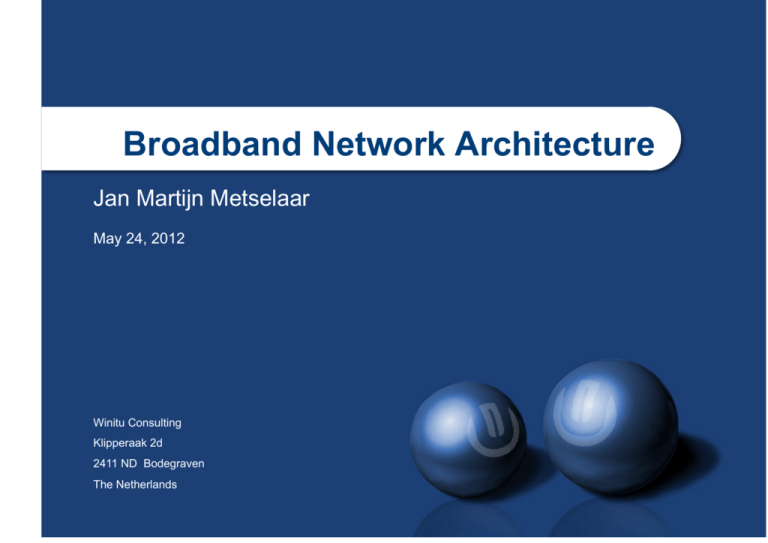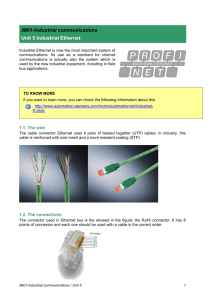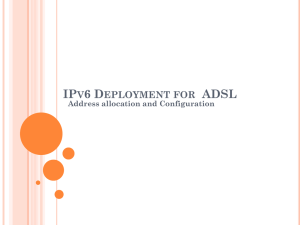Broadband Network Architecture
advertisement

Broadband Network Architecture Jan Martijn Metselaar May 24, 2012 Winitu Consulting Klipperaak 2d 2411 ND Bodegraven The Netherlands slide Broadband Services ! Dual play, Triple play, Multi play ! But what does the end-user care? ! Nice those triple play services, but how do you get the content to the subscribers? ! Smart network architecture… and a lot of IP packets slide 2 Current broadband services over FTTH networks ! Internet access ! Unicast IP (Duh…) ! Television ! IP unicast for video-on-demand ! IP multicast for broadcast television (the ‘default’ package of 50 channels) ! Telephony ! SIP signaling, RTP for transport slide 3 Network Architecture – Layered model ! Access ! Lots of individual connections ! Focus on physical aggregation of lines ! Security ! Distribution ! Connection towards access layer ! Focus on logical aggregation of connections ! Route summarization ! Core ! Connection towards the distribution layer ! Focus on traffic volume ! No identification of individual connections slide 4 Network Architecture – Layered model Service provider 1 Service provider 2 Core netwerk core metro access slide 5 Discussion ! The how and why of current broadband networks ! Protocols? ! Speeds? ! Possibilities? ! Restrictions? slide 6 Network Architecture – Ethernet as uniform transport protocol Leased line ATM Frame Relay X.25 Ethernet PPP Ethernet Packet over Sonet (POS) SONET SDH STM-1, 4, 16 slide 7 Network structure – Domain separation Access Distributie / Core Core ISP 1 CPE backbone ISP 2 ISP 3 subscriber domain • Operator domain WWW PSTN/ISDN service provider domain “Wholesale” model: operator delivers network facilities to different content and service providers. slide 8 Network Architecture – Access: connection model How is the connection between subscriber and network realized? Point-to-Point Protocol (PPP) Ethernet Bridging “DHCP model” ! IP over PPP over Ethernet ! IP over Ethernet ! PPP session from the modem ! IP address assigment through into the distribution layer ! IP address assignment in PPP session setup via RADIUS ! ‘connection oriented’ ! Multiple PPP sessions for QoS DHCP ! ‘connection less’ ! QoS via Ethernet Class of service guarantees slide 9 Network Architecture – Core: MPLS VPN Ethernet Bridging CPE MPLS VPN VPN ISP SP 11 VPN Distributie / Core apparatuur VPN ISP SP 22 backbone ISP 1 ISP 2 ISP 3 VPN ISP SP 33 City PoP subscriber domain Operator domain service provider domain slide 10 Network Architecture – Core Network MPLS (Multi Protocol Label Switching) ! Support for VPNs ! Traffic Engineering (used for fast reroute and ip multicast traffic) ! Ethernet transport over MPLS IP Routing ! IGP ! For distributing ‘next-hop’ routing information ! OSPF or IS-IS ! M-BGP ! For distributing IPv4 prefixes slide 11 Network Architecture – MPLS primer: labels IP packet L1 IP packet L2 IP packet L3 IP packet IP packet • • • • • Label Switched Router (LSR) MPLS enabled router Forwarding based on Labels, forwarding control separated from forwarding plane Labels are distributed via Label Distributie Protocol (LDP) LDP hello packets are UDP and transported via broadcast of multicast Multiple labels (stack) per packet possible (note that MTU must be large enough!) slide 12 Network Architecture – MPLS primer: forwarding Routing information exchange Control plane inside a node with other routers IP rou>ng protocols IP rou>ng table Label informa>on Base (LIB) MPLS IP rou>ng control Label binding exchange with different routers Data plane inside a node Forwarding Informa>on Base (FIB) Label Forwarding informa>on Base (LFIB) slide 13 Complexiteit Network Architecture – Increasing complexity Triple play Dual play Single play Multiplay slide 14 Quizzz ! What about Quality of Service? ! What about Security? slide 15 Network Architecture – Quality of Service Core network ! QoS only relevant if congestion can occur ! Used to be irrelevant in broadband networks as bandwidth was plenty. FTTH and Docsis3 has changed this. ! QoS policy of most providers was: “upgrade capacity”. Currently large providers are running into technological limits: 10GE is not fast enough and 100GE is not yet there! ! Cost for service providers is increasing rapidly ! Traffic is becoming more symmetrical slide 16 Network Architecture – Quality of Service Access networks ! Multi-play services all use the same connection ! Voice traffic needs to be protected ! Video needs to get enough bandwidth (otherwise you’ll see blocks) ! Video and voice need protection from general internet traffic (especially P2P and news traffic) slide 17 Network Architecture – Quality of Service QoS enforcement QoS parameters downstream traffic On incoming traffic CPE backbone ISP 2 QoS transparent QoS parameters upstream traffic • IP QoS: precedence bits, diffserv • Ethernet QoS: Class of Service (priority bit in vlan header) • MPLS QoS: Exp. bits slide 18 Network Architecture – Security slide 19 Network Architecture – Security ! Network ! Access to network elements ! Access to network management systems ! Protocols ! “Security by obscurity” ! Control plane protection ! Services platform ! Policy: every service is responsible for it’s own platform ! Where possible network security can provide additional protection ! Separate users ! Spoofing filters ! User isolation ! Protocol filters (note that new OS like Windows Vista and 7 bring new challenges, like IPv6 default enabled). slide 20 Network Architecture – Security Attack Vectors ! ARP flood attack, plus spoofing ! DHCP flood attack ! MAC flood attack, plus spoofing ! IGMP flood attack ! IPv4 broadcast flood attacks ! IPv4 unicast flood attack ! TTL=1 attack ! IP options attack ! IPv6 MLD ! … some others. Focused on the control plane of the routers and switches in the network. Most are denial of service attacks, but some can be used for a ‘man-in-the-middle’ attack. slide 21 Network Architecture – Security (DHCP) Spoofing filters Arp filtering Security by obscurity (that which is not reachable is secure) CPE backbone ISP 2 Reverse path check CPE configuration Security force configuration Private vlan’s vlan filtering from a central server slide 22 Network Architecture – FTTH networks Security toolbox DHCP snooping Dynamic Arp Inspection Private VLAN PFC based special case VACL Layer-2 filtering: Hardware limiters - Allow ethertypes 0x800 and 0x806 - Broadcast ARP filtering - Multicast filtering - Broadcast redirection Multicast route limit Control plane policing uRPF STP filtering Ethertype filtering: Ip local proxy-arp ARP rate-limiting - 0x800 0x806 (IP & ARP) PIM neighbor filtering DHCP rate-limiting IGMP group filtering IGMP group limiting UUFB UMFB Port-security IPSG Storm-control slide 23 Network Architecture – IPv6 adressing ! IPv4: adress 32-bit ! 10.100.34.123 ! IPv6: adress 64-bit ! 2031:0000:130F:0000:0000:09C0:876A:130B ! IPv6 display ! 2031:0:130F::9C0:876A:130B ! Leading ‘0’ in a segment is optional ! Use double colon ‘::’ to summarise two segments with 0’s allowed only once in an address. slide 24 Network Architecture – IPv6 adressing ! Adress scopes: ! Unicast – single host or interface ! Anycast – group of hosts or interfaces ! Multicast – group of receivers ! There are no IPv6 broadcast adresses (!) ! Adress types: ! Link-local adres, starts with FE80:: /10 ! Site-local adres, stars with FEC0:: /10 ! Global aggregate adress, worldwide unique slide 25 Network Architecture – IPv6 adressing ! Growth of connected networks and hosts exhausts the available IPv4 addresses solution is IPv6 ! Support for IPv6 is low ! Most equipment is ‘IPv6 ready’ but not ‘full IPv6’ ! Performance often only about 50% compared to IPv4 performance ! (Legacy) applications usually not IPv6 ready ! Migration to IPv6 will take a long time ! IPv6 is incompatible with IPv4 (there is no implicit migration path in the IPv6 protocol design) Bron: http://ran.psg.com/~randy/070722.v6-op-reality.pdf slide 26 Network Architecture – IPv6 migration scenarios ! Dual-Stack – both IPv4 and IPv6 running on one system ! Investments in the whole end-to-end network ! All components must support IPv6 ! Best route to IPv6 only ! Carrier grade NAT ! Scalability issues ! Tunneling IPv6 in IPv4 ! Schalability, and what does it solve? ! ISP world embraces Dual-Stack ! DNS is a challenge (what first? v4 of v6) slide 27 Network Architecture – IPv6 – Dual-Stack (DHCP) Spoofing filters – IPv6 Arp filtering – IPv6 IPv6 backbone CPE IPv4 backbone IPv6 Internet IPv4 Internet CPE configuration security configuration envoforcement from central provisioning system also IPv6 slide 28 Quizzz ! Netwerk management? ! Why does that seem to be so difficult for most Service Providers? slide 29 Network IT - Provisioning ! We like “zero touch” , “flow through” provisioning. Service providers would like to focus on “exception management” only… ! Bullshit or …? slide 30 Network IT – Provisioning ! The success of network provisioning and order management is correct and complete information: ! Orders ! Subscriber connections ! Automation is the key, every manual action increases the chance of mistakes slide 31 Network and IT – Systems slide 32 That’s all for now! Questions? Don’t hesitate to send an email to: janmartijn @ winitu.com slide 33




